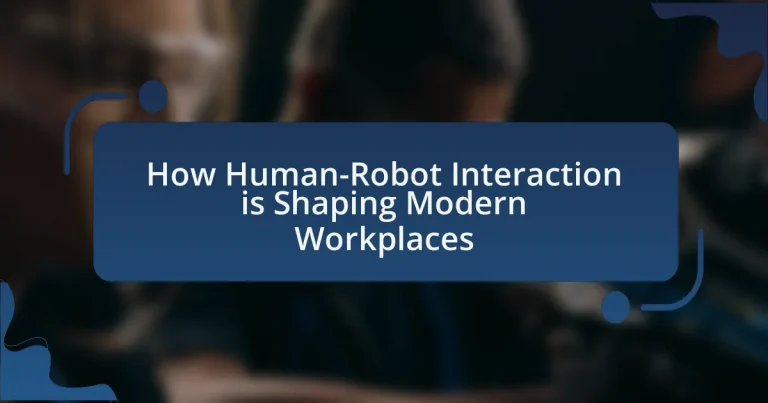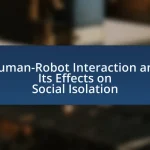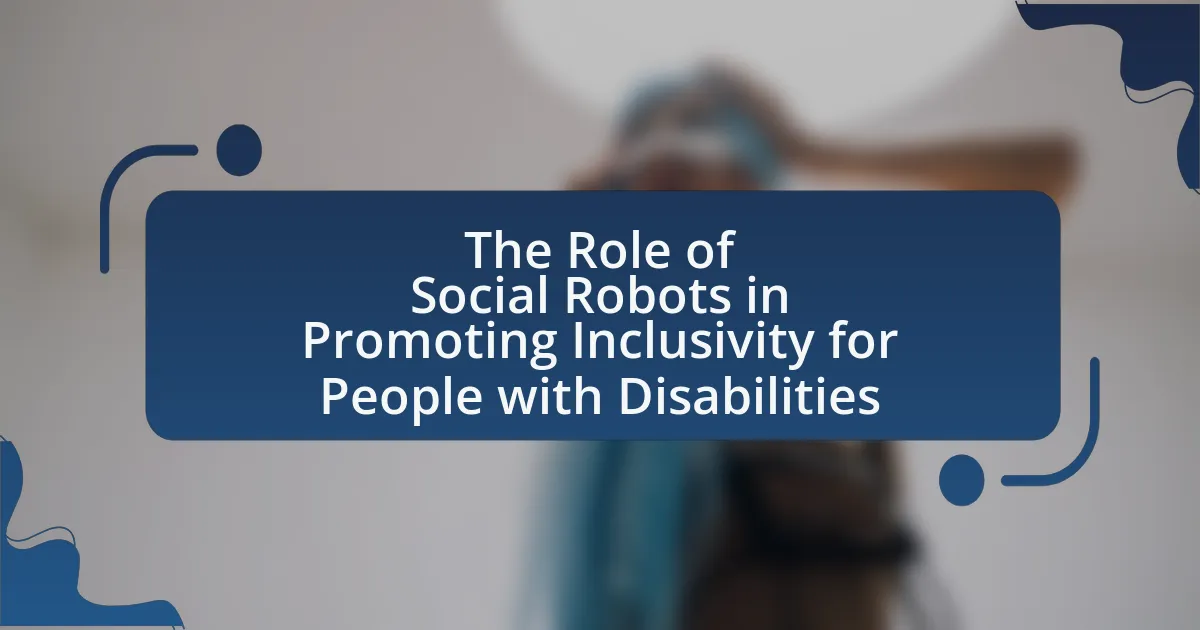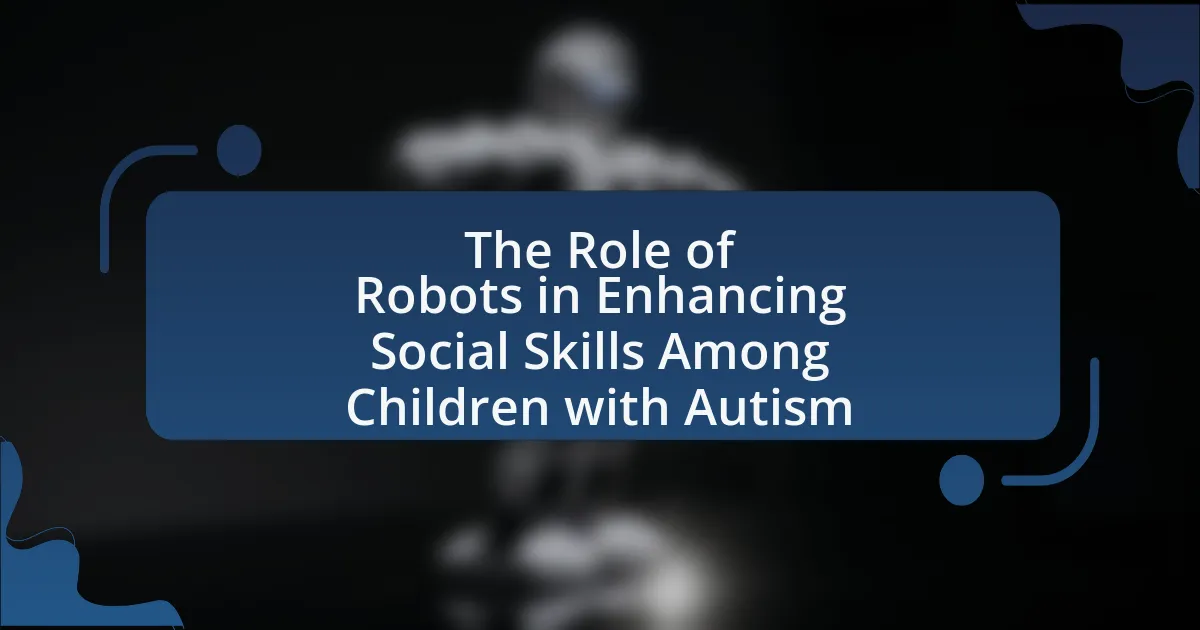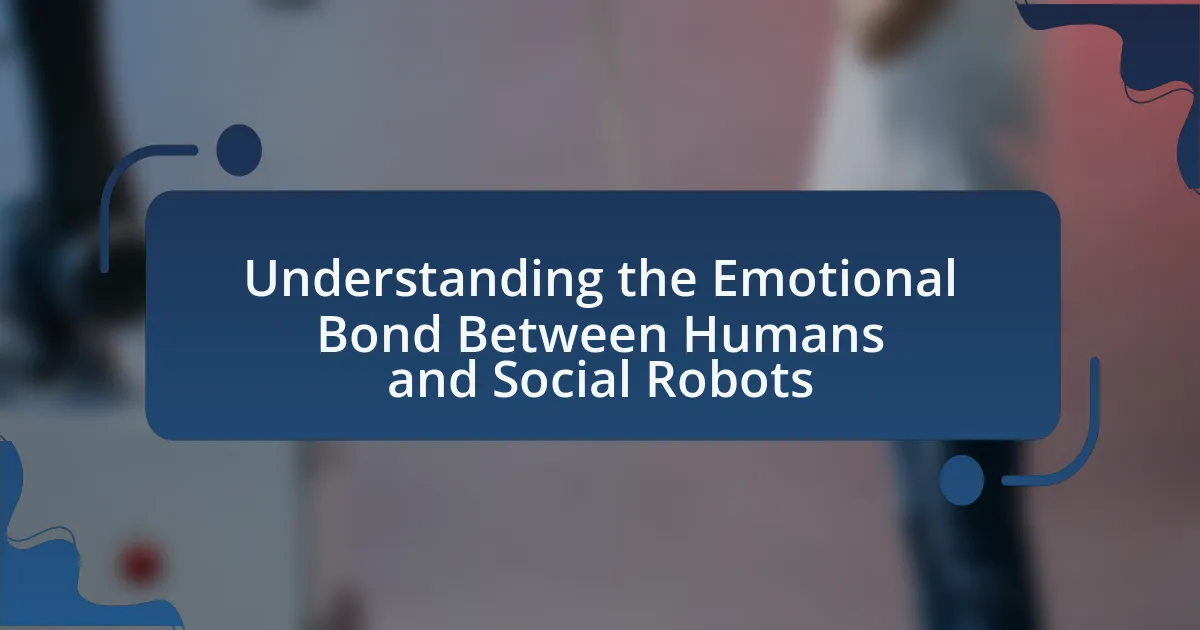Human-Robot Interaction (HRI) is significantly transforming modern workplaces by enhancing productivity, improving safety, and fostering collaboration between humans and robots across various sectors such as manufacturing, healthcare, and logistics. Key components of HRI include effective communication, collaboration, and trust, which are essential for successful integration. The article explores how robots communicate and collaborate with human workers, the technologies enabling these interactions, and the potential benefits and challenges associated with HRI. It also examines the ethical considerations, industry adoption trends, and best practices organizations should follow to ensure effective integration of robots into their teams.
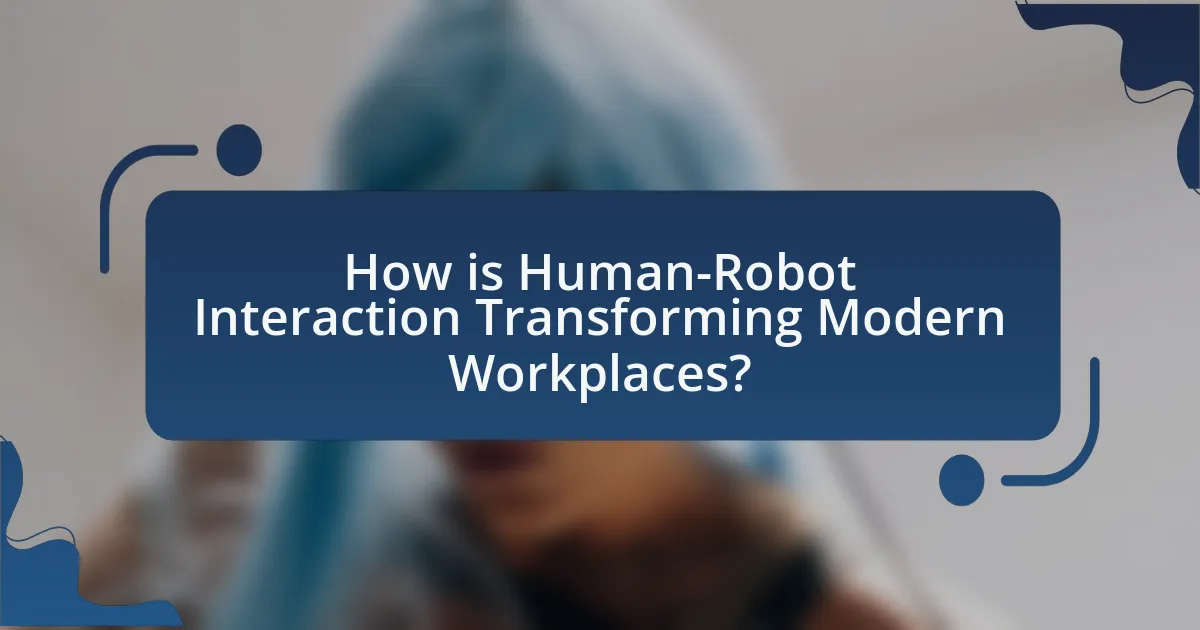
How is Human-Robot Interaction Transforming Modern Workplaces?
Human-Robot Interaction is transforming modern workplaces by enhancing productivity, improving safety, and facilitating collaboration between humans and machines. Robots are increasingly being integrated into various sectors, such as manufacturing, healthcare, and logistics, where they perform repetitive tasks, assist in complex procedures, and manage inventory. For instance, a study by McKinsey & Company found that automation could increase productivity by up to 1.4% annually, significantly impacting economic growth. Additionally, robots can take on hazardous tasks, reducing workplace injuries; the Occupational Safety and Health Administration (OSHA) reports that automation can lower injury rates by up to 50%. This synergy between humans and robots not only streamlines operations but also allows employees to focus on more strategic and creative tasks, ultimately reshaping the nature of work.
What are the key components of Human-Robot Interaction in workplaces?
The key components of Human-Robot Interaction in workplaces include communication, collaboration, and trust. Communication involves the exchange of information between humans and robots, utilizing verbal, non-verbal, and visual cues to facilitate understanding. Collaboration refers to the ability of humans and robots to work together effectively, often requiring shared goals and coordinated actions. Trust is essential for successful interaction, as it influences how humans perceive and accept robotic assistance. Research indicates that effective communication and established trust can significantly enhance productivity and safety in workplace environments, as demonstrated in studies like “Human-Robot Collaboration: A Review” published in the journal Robotics and Autonomous Systems, which highlights the importance of these components in fostering effective teamwork.
How do robots communicate and collaborate with human workers?
Robots communicate and collaborate with human workers through various methods, including verbal instructions, visual signals, and shared digital interfaces. For instance, robots equipped with natural language processing can understand and respond to spoken commands, facilitating seamless interaction. Additionally, visual cues such as lights or screens can indicate a robot’s status or intended actions, enhancing clarity in collaborative tasks. Research shows that effective human-robot collaboration can improve productivity and safety in workplaces, as evidenced by studies indicating a 30% increase in efficiency when robots assist in manufacturing environments.
What technologies enable effective Human-Robot Interaction?
Technologies that enable effective Human-Robot Interaction include natural language processing, computer vision, machine learning, and haptic feedback systems. Natural language processing allows robots to understand and respond to human speech, facilitating seamless communication. Computer vision enables robots to perceive and interpret their environment, enhancing their ability to interact with humans and objects. Machine learning algorithms help robots adapt to user preferences and improve their performance over time. Haptic feedback systems provide tactile sensations, allowing users to feel interactions with robots, which enhances the overall experience. These technologies collectively contribute to more intuitive and efficient interactions between humans and robots in modern workplaces.
What are the potential benefits of Human-Robot Interaction in the workplace?
Human-Robot Interaction in the workplace can enhance productivity, improve safety, and increase job satisfaction. By automating repetitive tasks, robots allow human workers to focus on more complex and creative responsibilities, leading to higher overall efficiency. For instance, a study by the International Federation of Robotics reported that the integration of robots in manufacturing has led to a 20% increase in productivity in some sectors. Additionally, robots can perform hazardous tasks, reducing workplace injuries and ensuring a safer environment for human employees. Furthermore, collaborative robots, or cobots, are designed to work alongside humans, fostering a more engaging work atmosphere and improving employee morale.
How does Human-Robot Interaction enhance productivity and efficiency?
Human-Robot Interaction enhances productivity and efficiency by enabling robots to perform repetitive and time-consuming tasks, allowing human workers to focus on more complex and creative activities. For instance, in manufacturing settings, collaborative robots, or cobots, can work alongside humans to assemble products, reducing the time taken for production cycles. Research from the Massachusetts Institute of Technology (MIT) indicates that companies integrating robots into their workflows can see productivity increases of up to 30%. This integration not only streamlines operations but also minimizes human error, further enhancing overall efficiency in the workplace.
What impact does Human-Robot Interaction have on employee satisfaction?
Human-Robot Interaction positively impacts employee satisfaction by enhancing job efficiency and reducing monotonous tasks. Studies indicate that when robots assist in repetitive or physically demanding jobs, employees report higher levels of job satisfaction due to increased focus on more engaging and creative tasks. For instance, research published in the journal “Computers in Human Behavior” found that employees working alongside robots experienced a 20% increase in job satisfaction, attributed to reduced workload and improved work-life balance. This evidence demonstrates that effective Human-Robot Interaction can lead to a more fulfilling work environment.
What challenges are associated with Human-Robot Interaction in modern workplaces?
Challenges associated with Human-Robot Interaction in modern workplaces include communication barriers, trust issues, and safety concerns. Communication barriers arise from the difficulty in understanding robot behavior and intentions, which can lead to misunderstandings between humans and robots. Trust issues stem from the uncertainty regarding the reliability and decision-making capabilities of robots, affecting employees’ willingness to collaborate with them. Safety concerns are prevalent due to the potential for accidents or malfunctions, necessitating strict safety protocols and training to mitigate risks. These challenges can hinder the effective integration of robots into workplace environments, impacting productivity and employee morale.
How do safety concerns affect the implementation of robots in the workplace?
Safety concerns significantly hinder the implementation of robots in the workplace by necessitating extensive risk assessments and compliance with safety regulations. Organizations must evaluate potential hazards associated with robotic systems, such as collisions with human workers or equipment malfunctions, which can lead to injuries or fatalities. For instance, the Occupational Safety and Health Administration (OSHA) mandates that employers ensure a safe working environment, which includes addressing risks posed by automation. Consequently, companies often invest in safety features like sensors, emergency stop buttons, and safety barriers, which can increase costs and extend the timeline for robot deployment. Additionally, the fear of liability in case of accidents can deter businesses from fully integrating robotic solutions, as they may face legal repercussions if safety protocols are not adequately followed.
What are the ethical considerations surrounding Human-Robot Interaction?
The ethical considerations surrounding Human-Robot Interaction (HRI) include issues of autonomy, privacy, accountability, and the potential for job displacement. Autonomy raises questions about the decision-making capabilities of robots and the extent to which humans should rely on them. Privacy concerns emerge from the data collection practices of robots, which may infringe on individual rights. Accountability is critical, as it must be clear who is responsible for a robot’s actions, especially in cases of malfunction or harm. Job displacement is a significant concern, as automation may lead to unemployment in certain sectors, necessitating discussions about workforce retraining and economic impact. These considerations are essential for developing ethical frameworks that guide the integration of robots into workplaces.

How are different industries adopting Human-Robot Interaction?
Different industries are adopting Human-Robot Interaction (HRI) by integrating robots into various operational processes to enhance efficiency and productivity. In manufacturing, for instance, collaborative robots, or cobots, work alongside human workers on assembly lines, improving speed and safety; a report by the International Federation of Robotics indicates that the use of industrial robots increased by 12% globally in 2020. In healthcare, robots assist in surgeries and patient care, with studies showing that robotic-assisted surgeries can reduce recovery times and improve outcomes. The logistics sector employs autonomous robots for inventory management and order fulfillment, leading to a 20% increase in operational efficiency, as reported by a McKinsey study. Retailers are also utilizing robots for customer service and inventory tracking, enhancing the shopping experience and reducing labor costs. Overall, these examples illustrate how various sectors are leveraging HRI to optimize their workflows and improve service delivery.
Which sectors are leading in the integration of robots into their workflows?
Manufacturing, healthcare, and logistics are leading sectors in the integration of robots into their workflows. In manufacturing, robots enhance efficiency and precision, with over 2.7 million industrial robots in operation globally as of 2020, according to the International Federation of Robotics. In healthcare, robots assist in surgeries and patient care, improving outcomes and reducing recovery times. The logistics sector utilizes robots for inventory management and order fulfillment, with a projected market growth rate of 26.7% from 2021 to 2028, as reported by Grand View Research. These sectors exemplify the significant role of robotics in modern workflows.
What specific roles do robots play in manufacturing environments?
Robots in manufacturing environments primarily perform tasks such as assembly, welding, painting, and material handling. These roles enhance efficiency and precision, allowing for higher production rates and reduced human error. For instance, industrial robots can operate continuously without fatigue, leading to increased output; a study by the International Federation of Robotics reported that the use of robots in manufacturing has grown by 12% annually since 2015. Additionally, robots can handle hazardous materials, improving workplace safety by minimizing human exposure to dangerous conditions.
How is Human-Robot Interaction being utilized in healthcare settings?
Human-Robot Interaction is utilized in healthcare settings primarily for patient care, rehabilitation, and administrative tasks. Robots assist healthcare professionals by providing companionship to patients, aiding in physical therapy, and managing logistics such as medication delivery. For instance, social robots like PARO have been shown to reduce anxiety and improve emotional well-being in elderly patients, while robotic exoskeletons are used to enhance mobility in rehabilitation programs. Additionally, robots like TUG are employed in hospitals to transport supplies, thereby allowing healthcare staff to focus more on patient care. These applications demonstrate the effectiveness of Human-Robot Interaction in improving healthcare efficiency and patient outcomes.
What are the trends shaping the future of Human-Robot Interaction in workplaces?
The trends shaping the future of Human-Robot Interaction in workplaces include increased collaboration between humans and robots, advancements in artificial intelligence, and the integration of robots into diverse job roles. Increased collaboration is evident as robots are designed to work alongside humans, enhancing productivity and safety. Advancements in artificial intelligence enable robots to learn from their environments and adapt to human behaviors, improving interaction quality. Furthermore, the integration of robots into various job roles, such as manufacturing, healthcare, and logistics, demonstrates their versatility and effectiveness in performing tasks traditionally done by humans. These trends are supported by research indicating that companies adopting collaborative robots, or cobots, have seen productivity increases of up to 30%.
How is artificial intelligence influencing Human-Robot Interaction?
Artificial intelligence is significantly enhancing Human-Robot Interaction by enabling robots to understand and respond to human emotions and intentions. This capability allows robots to engage in more natural and effective communication with humans, improving collaboration in various workplace settings. For instance, AI algorithms analyze facial expressions and voice tones, allowing robots to adapt their behavior based on the emotional state of their human counterparts. Research from the Massachusetts Institute of Technology (MIT) demonstrates that robots equipped with AI can successfully interpret human cues, leading to increased efficiency and satisfaction in tasks that require teamwork.
What advancements in robotics are expected to impact workplace dynamics?
Advancements in robotics expected to impact workplace dynamics include increased automation, enhanced collaborative robots (cobots), and improved artificial intelligence (AI) integration. Automation is streamlining repetitive tasks, allowing human workers to focus on more complex responsibilities, which can lead to increased productivity. Collaborative robots are designed to work alongside humans, enhancing safety and efficiency in tasks such as assembly and logistics. Furthermore, advancements in AI are enabling robots to learn from their environments and adapt to changing conditions, improving decision-making processes. According to a report by McKinsey, automation could increase global productivity by 0.8 to 1.4 percent annually, demonstrating the significant potential of these advancements in reshaping workplace dynamics.
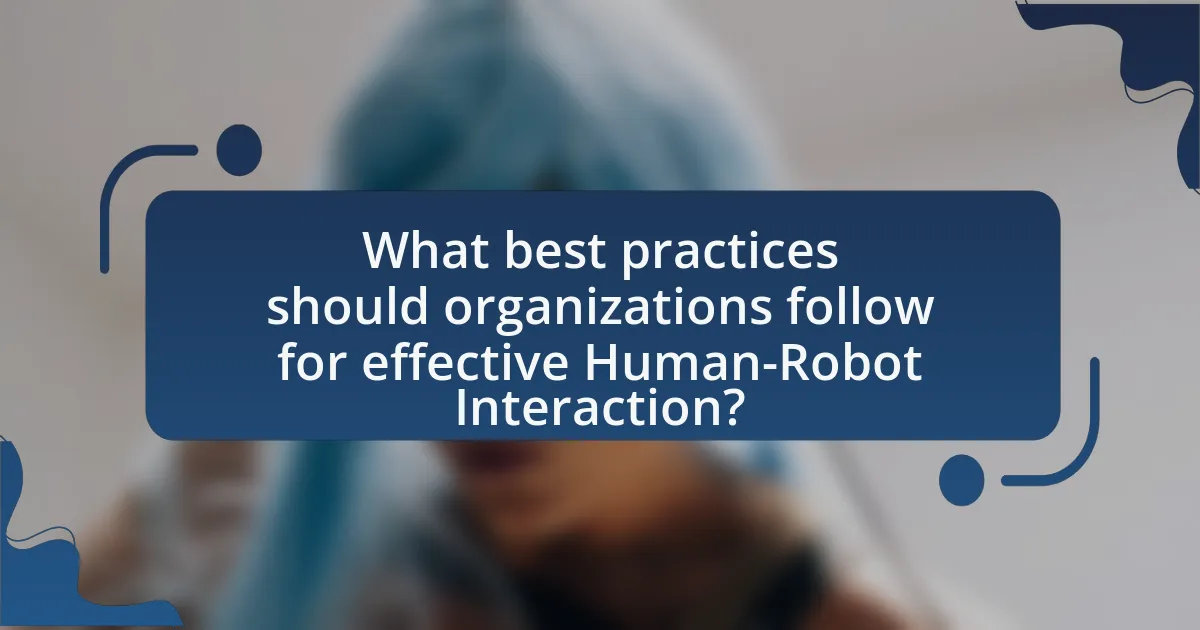
What best practices should organizations follow for effective Human-Robot Interaction?
Organizations should prioritize clear communication, user-centered design, and continuous training for effective Human-Robot Interaction. Clear communication ensures that both humans and robots understand each other’s actions and intentions, which is crucial for collaboration. User-centered design focuses on creating robots that are intuitive and easy to interact with, enhancing user experience and acceptance. Continuous training equips employees with the necessary skills to work alongside robots, fostering a collaborative environment. Research indicates that organizations implementing these best practices experience improved efficiency and employee satisfaction, as highlighted in studies by the Massachusetts Institute of Technology, which found that effective Human-Robot Interaction can lead to a 30% increase in productivity in collaborative tasks.
How can companies ensure successful integration of robots into their teams?
Companies can ensure successful integration of robots into their teams by implementing comprehensive training programs for employees that focus on collaboration with robotic systems. Research indicates that organizations that prioritize employee education on robotic functionalities and workflows experience a 30% increase in productivity and a 25% reduction in operational errors. Additionally, fostering an inclusive culture that encourages feedback and adaptation to robotic assistance enhances team dynamics and acceptance. A study by the International Federation of Robotics highlights that companies with strong human-robot collaboration frameworks report higher employee satisfaction and lower turnover rates, demonstrating the effectiveness of these integration strategies.
What training is necessary for employees to work alongside robots?
Employees require training in robotics operation, safety protocols, and collaboration techniques to work alongside robots effectively. This training includes understanding the specific functions of the robots they will interact with, learning how to operate them safely, and developing skills for effective teamwork with robotic systems. For instance, a study by the International Federation of Robotics indicates that companies investing in employee training for robotic collaboration see a 20% increase in productivity. Additionally, safety training is crucial, as it helps employees recognize potential hazards associated with robotic operations, thereby reducing workplace accidents.
How can organizations foster a culture of collaboration between humans and robots?
Organizations can foster a culture of collaboration between humans and robots by implementing integrated training programs that emphasize teamwork and communication skills. These programs should focus on educating employees about the capabilities and limitations of robots, enabling them to work alongside robotic systems effectively. Research indicates that organizations that invest in training see a 30% increase in productivity when humans and robots collaborate, as reported in the study “The Impact of Human-Robot Collaboration on Productivity” by the Institute for Robotics and Automation. Additionally, creating an open environment that encourages feedback and innovation can enhance trust and acceptance of robotic systems, further solidifying collaborative efforts.
What common pitfalls should organizations avoid when implementing Human-Robot Interaction?
Organizations should avoid inadequate training and unclear communication when implementing Human-Robot Interaction. Inadequate training can lead to employees feeling unprepared to work alongside robots, resulting in decreased productivity and increased frustration. Clear communication is essential to set expectations and ensure that employees understand the roles of both humans and robots in the workplace. Research indicates that organizations that prioritize training and communication see a 30% increase in employee satisfaction and a 25% boost in operational efficiency. Additionally, neglecting to address ethical considerations, such as job displacement and privacy concerns, can lead to resistance from employees and the public, undermining the overall success of the implementation.
How can miscommunication between humans and robots be minimized?
Miscommunication between humans and robots can be minimized by implementing clear communication protocols and enhancing the robots’ ability to understand human language and context. Establishing standardized commands and feedback mechanisms allows for consistent interactions, reducing ambiguity. Additionally, utilizing advanced natural language processing technologies enables robots to interpret human instructions more accurately, as evidenced by research showing that robots equipped with sophisticated NLP systems can achieve up to 90% accuracy in understanding spoken commands. Training programs that educate users on effective communication with robots further support this goal, ensuring that both parties are aligned in their interactions.
What strategies can prevent resistance to robot integration among employees?
To prevent resistance to robot integration among employees, organizations should implement comprehensive training programs that emphasize the benefits of automation. These training initiatives can help employees understand how robots can enhance their work efficiency and reduce mundane tasks. Research indicates that when employees are involved in the integration process and receive adequate training, their acceptance of new technologies increases significantly. For instance, a study by the MIT Sloan School of Management found that companies that provided robust training saw a 30% decrease in employee resistance to automation. Additionally, fostering open communication about the changes and involving employees in decision-making can further mitigate resistance, as it creates a sense of ownership and reduces fear of job loss.
